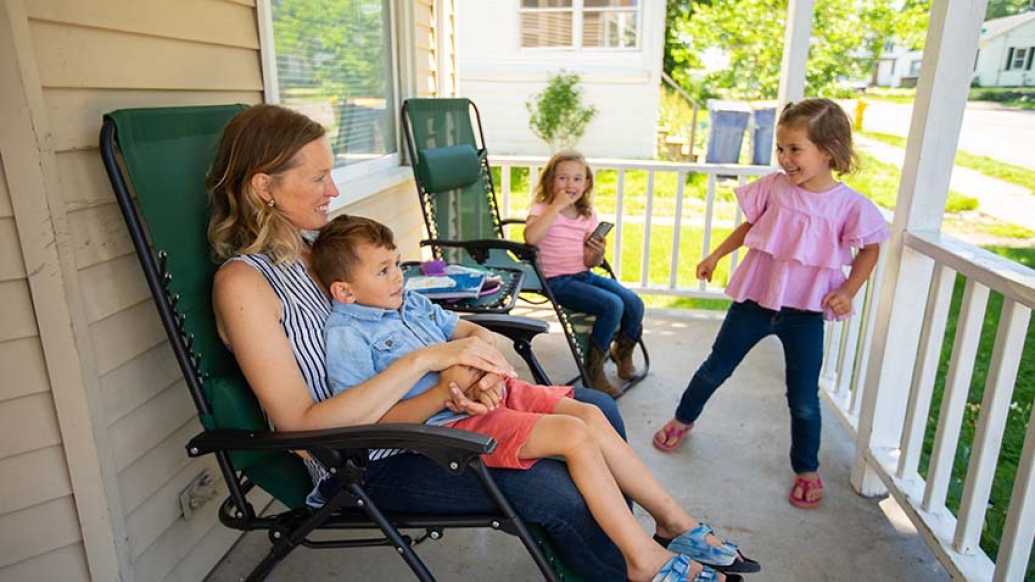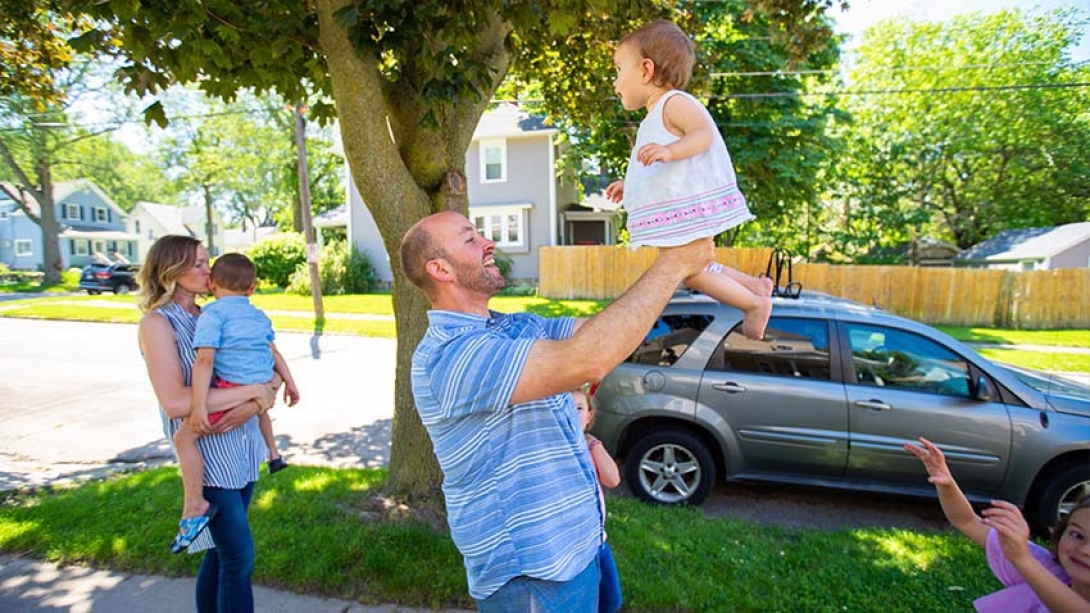Morgan Evans thought she’d have to choose between her unborn baby and treating her aggressive tongue cancer. Her team at Michigan Medicine thought otherwise.
8:54 AM
Author |

Morgan Evans, mom to three young girls, was 14 weeks pregnant with her fourth child when she scheduled what she assumed would be a routine dental appointment in 2014.
"I went to the dentist, and I said 'I have this bump on my tongue that's been hurting me,'" said Evans. "And he said 'you need to see an oral surgeon and have that biopsied.' I thought it seemed really mean to tell a pregnant lady she might have cancer, but that's what it ended up being."
The bump on her tongue was diagnosed as squamous cell carcinoma, an aggressive cancer requiring surgical removal of the tumor along with radiation and chemotherapy treatments. However, Evans' pregnancy complicated the matter.
"Generally what would be done in this scenario was to either terminate the pregnancy to allow the patient to get full-course treatment, or delay the treatment of the patient," said Brent Ward, M.D.,D.D.S., the oral and maxillofacial surgeon Evans was referred to at Michigan Medicine. "This was more or less the standard."
"It was devastating to hear that those were my two options," said Evans.
Evans and her husband had about a week between appointments to weigh the options and make a decision. Yet when they arrived at the next appointment, Ward presented a potential alternative.
"I'd been to meetings as recently as a year before where the discussion revolved around the treatment of pregnant patients with cancer," said Ward. "And then I thought about the unique setting we have here at the University of Michigan and all the people we work with that could come together as a team and say 'hey, we're going to try to do this differently."
Ward enlisted colleagues including Deborah Berman, M.D., from maternal and fetal medicine, and Sean Edwards, M.D., D.D.S., another oral and maxillofacial surgeon, to collaborate on Evans' surgery and treatment.
"I remember the day Brent Ward called the department of obstetrics and gynecology and the division of maternal and fetal medicine," said Berman. "He said 'we need some help; we need to figure this out.'"
"I told [Dr. Berman] that I had a patient here who would like full course treatment because she wants to live, but she also is carrying a baby and would like to hang on to that baby," said Ward. "By working with maternal and fetal medicine, we decided to treat Morgan while protecting her unborn child."
Berman, Edwards and Ward, along with their respective teams and colleagues from oncology, devised a surgery and treatment plan for Evans that involved removing the tumor, reconstructing her tongue, and subsequent chemotherapy and radiation treatments. During the surgical procedure, Ward oversaw removal of the tumor while Edwards handled the tongue reconstruction – a crucial component of Evans' future well-being.
"The tongue is very critical for a variety of things: oral hygiene, speech, swallowing,] and more. With that in mind, we have a variety of reconstruction options that we choose," said Edwards. "When somebody loses a portion of their tongue, we always go through a bit of calculus trying to decide what will give them back the most function."
The most common operation to replace a significant portion of the tongue (and the one chosen for Evans) involves using a portion of the patient's forearm to create a flap based on the shape and size of the piece of tongue being removed. The procedure requires the removal of skin and fascia from the forearm, as well as an artery and veins in order to give and drain blood supply from the flap so it remains viable, as well as flexible enough to preserve function. While standard, it's a delicate operation, particularly with multiple teams working in tandem.
"After Dr. Ward removed the cancer, I could start crafting the reconstruction. From that point on, we're working simultaneously," said Edwards. "While I'm elevating the flap from the forearm, he's removing lymph nodes from the neck. From the time we began to the time we closed the wound in the neck, it was about an 8-hour operation. That sounds like the better part of a day, but 15 years ago – before we were this coordinated – it would have been a 20 plus hour process."
That careful orchestration and streamlined timetable also kept the time Evans had to be under anesthesia to a minimum.
"It was important for us to be able to get her on and off the operating room table as quickly as possible," said Ward. "The baby is under anesthesia at this time as well," said Edwards. "Everything that we can do to plan ahead and work through a case to be as efficient as possible benefits both mom and baby."
Evans' recovery from surgery was challenging.
"Being in the hospital after the surgery was the most pain and the most fear I've ever experienced," said Evans. In addition to coping with the pain, Evans had to re-learn everyday skills such as speaking and eating with her newly-reconstructed tongue.

While Evans recovered from the surgery, Berman's team from maternal and fetal medicine worked with oncology to devise a strategy to treat Evans while monitoring and protecting the baby throughout the duration of her pregnancy.
MORE FROM MICHIGAN: Sign up for our weekly newsletter
"We know that many chemotherapies can affect fetal growth," said Berman. "So we monitored her baby's growth in our ultrasound unit. With radiation, a really important step is to shield the baby, so while Morgan was receiving radiation in her area that needed treatment, her entire abdomen and pelvis were shielded."
Throughout the process, Berman was impressed by Evans' commitment. "Her strength was amazing," said Berman. "Knowing she was hurting from her surgery, and growing a baby, and hoping for her health, and hoping for her baby's health – I think her strength is what kept her going and kept her family's strength there."
Ward agrees that, in this case so dependent upon teamwork, Evans was perhaps the most important member of the team.
"I'm frequently inspired by my patients and what they're willing to do. But Morgan was particularly special," he said. "She showed up that day and was willing to put her trust in us, and we trusted her to do her part, which was to go through challenging and difficult things to receive this treatment. It was one of those really unique experiences where everybody came together in a way that allowed for an outcome that probably couldn't have been achieved at other places."
Evans celebrated being cancer-free for five years in October 2019. The son she was carrying at the time of her surgery continues to thrive, and she's since had another child, a daughter.
"Morgan really wanted to live, to keep going," said Ward. "She didn't want to make any compromises that would not allow her to keep going on and doing the things that she wants to do, particularly for those little ones at home. She was willing to take that chance and be able to go through all of this while being pregnant, which is pretty amazing."
Evans' outcome has also become something other teams and institutions now look toward for inspiration.
"I've had the opportunity to take calls from people asking 'How would you treat a patient like this?'" said Ward. "And I've been able to say, well, at the University of Michigan, here's how we would do it."

Explore a variety of healthcare news & stories by visiting the Health Lab home page for more articles.

Department of Communication at Michigan Medicine
Want top health & research news weekly? Sign up for Health Lab’s newsletters today!





